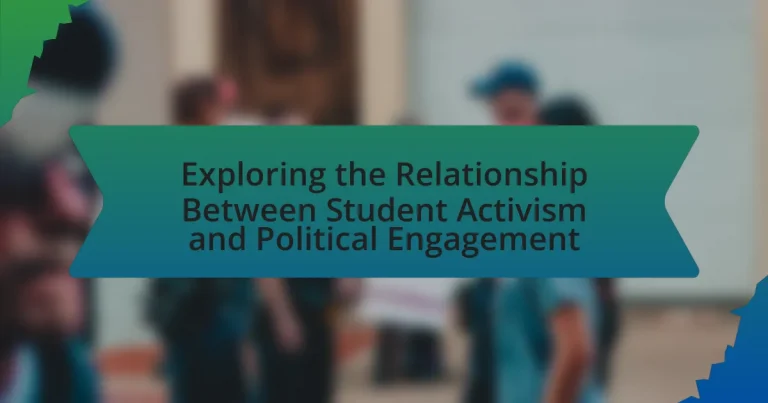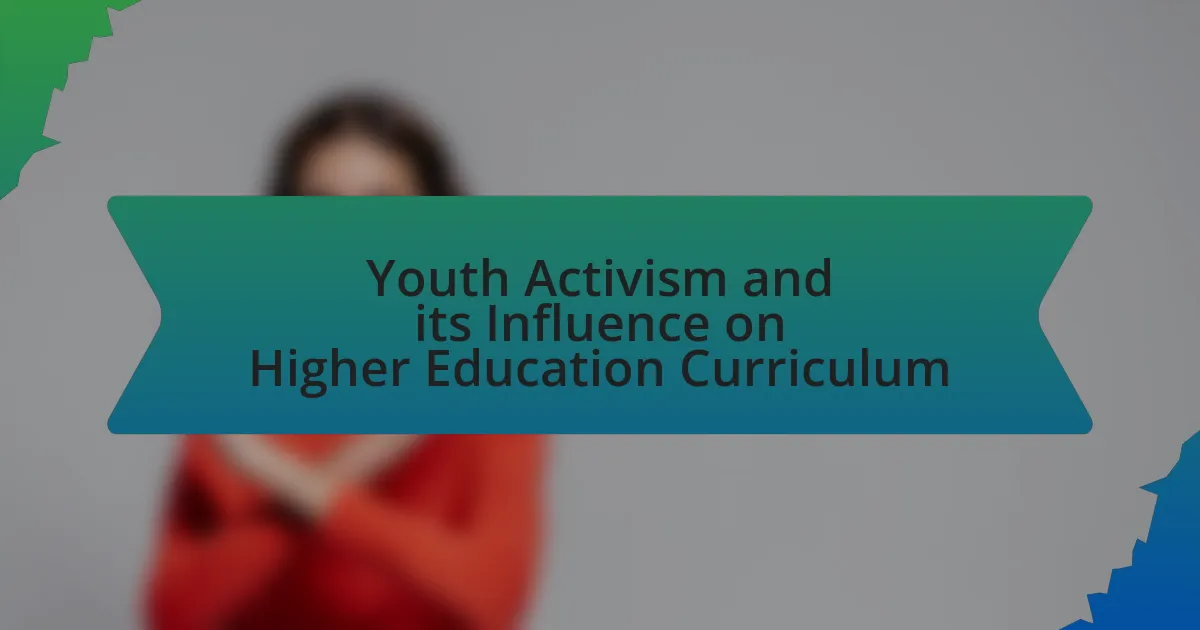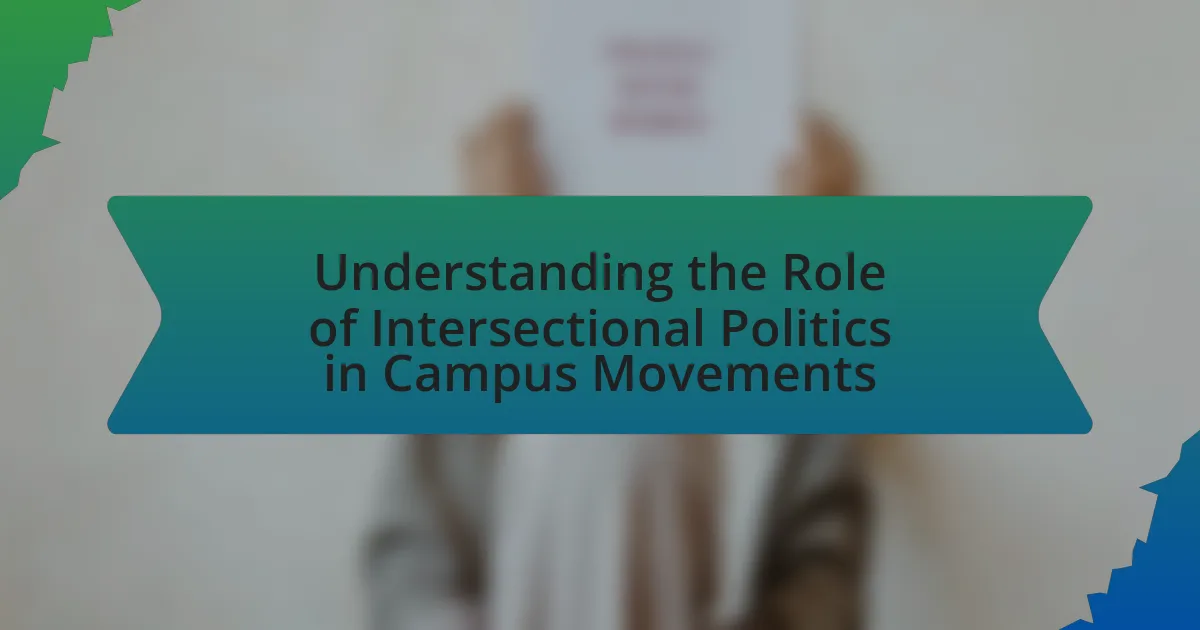The article explores the relationship between student activism and political engagement, highlighting how activism serves as a catalyst for young individuals to participate in political processes. It discusses the intersection of activism and political engagement, illustrated through historical movements like the Civil Rights Movement and contemporary examples such as climate strikes. The article examines factors influencing student activism, including socio-economic status and social media, and outlines the impact of activism on voter participation and policy changes. Additionally, it addresses challenges faced by student activists and best practices for enhancing their effectiveness in political engagement.

What is the relationship between student activism and political engagement?
Student activism is closely linked to political engagement, as it often serves as a catalyst for young individuals to participate in political processes. Research indicates that students who engage in activism are more likely to vote, join political organizations, and advocate for policy changes. For instance, a study by the Higher Education Research Institute found that students involved in activism during college are significantly more likely to remain politically active after graduation, demonstrating a direct correlation between the two. This relationship highlights how student activism not only raises awareness about social issues but also fosters a sense of civic responsibility and engagement in democratic processes.
How do student activism and political engagement intersect?
Student activism and political engagement intersect through the mobilization of students to advocate for social and political change, often influencing broader political discourse and policy. This intersection is evident in historical movements, such as the Civil Rights Movement, where student-led organizations like the Student Nonviolent Coordinating Committee played crucial roles in advocating for racial equality. Additionally, contemporary examples include climate strikes led by students, which have significantly impacted global climate policy discussions. Research indicates that students who engage in activism are more likely to participate in political processes, such as voting and campaigning, thereby reinforcing the connection between activism and political engagement.
What historical examples illustrate this relationship?
Historical examples that illustrate the relationship between student activism and political engagement include the Civil Rights Movement in the 1960s and the anti-Vietnam War protests. During the Civil Rights Movement, students from organizations like the Student Nonviolent Coordinating Committee (SNCC) played a crucial role in advocating for racial equality, organizing sit-ins and freedom rides that significantly influenced public policy and legislation, such as the Civil Rights Act of 1964. Similarly, the anti-Vietnam War protests, particularly those led by students at universities like Columbia and Berkeley, mobilized large numbers of young people against U.S. military involvement in Vietnam, contributing to a broader anti-war sentiment that ultimately affected U.S. foreign policy. These examples demonstrate how student activism can directly impact political engagement and societal change.
How do different forms of activism influence political participation?
Different forms of activism significantly influence political participation by mobilizing individuals and shaping public discourse. For instance, grassroots movements often engage communities directly, leading to increased voter turnout; the 2018 March for Our Lives, organized by students advocating for gun control, resulted in a notable rise in youth voter registration and participation in subsequent elections. Additionally, online activism, such as social media campaigns, has proven effective in raising awareness and encouraging political engagement, as seen in the #BlackLivesMatter movement, which galvanized millions to participate in protests and advocate for policy changes. These examples illustrate how various activism forms can create pathways for individuals to engage politically, thereby enhancing overall political participation.
Why is student activism important for political engagement?
Student activism is important for political engagement because it mobilizes young people to advocate for social change and influence policy decisions. Historically, student movements have played a crucial role in shaping political landscapes, such as the Civil Rights Movement in the United States, where student-led protests were pivotal in advancing civil rights legislation. Additionally, research indicates that students who engage in activism are more likely to participate in voting and civic activities later in life, fostering a culture of political involvement. This connection between activism and sustained political engagement underscores the significance of student activism in promoting democratic participation and social justice.
What role do students play in shaping political discourse?
Students play a crucial role in shaping political discourse by actively engaging in activism and advocacy, which influences public opinion and policy decisions. Through organized movements, protests, and campaigns, students raise awareness on critical issues such as climate change, social justice, and education reform. For instance, the March for Our Lives movement, initiated by students in response to gun violence, successfully brought national attention to gun control legislation, demonstrating the power of student-led initiatives in driving political conversations. Additionally, research indicates that student activism fosters civic engagement, with studies showing that students involved in political activities are more likely to vote and participate in democratic processes, further solidifying their impact on political discourse.
How does student activism impact policy changes?
Student activism significantly impacts policy changes by mobilizing collective action and raising awareness on critical issues. For instance, the student-led protests against gun violence in the United States, particularly after the Parkland shooting in 2018, resulted in legislative changes in several states, including the implementation of stricter gun control measures. Research from the Harvard Kennedy School indicates that youth activism can lead to increased political engagement and influence policymakers, as seen in the 2019 climate strikes organized by students worldwide, which pressured governments to adopt more aggressive climate policies. These examples demonstrate that student activism not only highlights societal issues but also drives tangible policy reforms through organized efforts and public discourse.
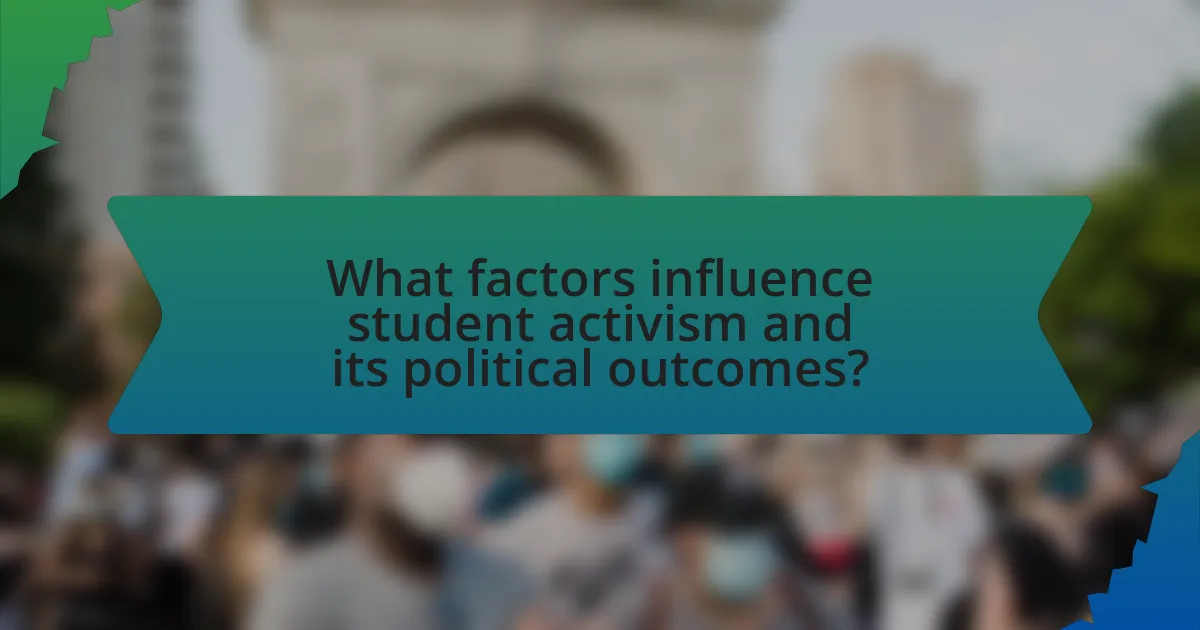
What factors influence student activism and its political outcomes?
Student activism is influenced by several key factors, including socio-economic status, educational environment, political climate, and social media engagement. Socio-economic status affects students’ access to resources and opportunities for activism; for instance, students from lower-income backgrounds may face more barriers to participation. The educational environment, including the presence of supportive faculty and active student organizations, can foster a culture of activism. Political climate plays a crucial role, as periods of social unrest or significant political events often mobilize students to engage in activism. Additionally, social media serves as a powerful tool for organizing and amplifying student voices, as evidenced by movements like the March for Our Lives, which utilized platforms like Twitter and Instagram to mobilize support and influence political outcomes. These factors collectively shape the effectiveness and direction of student activism, leading to varying political outcomes based on the context in which they occur.
How do social, economic, and cultural contexts affect student activism?
Social, economic, and cultural contexts significantly influence student activism by shaping the issues students prioritize and the methods they employ for advocacy. For instance, social contexts, such as prevailing social movements or peer networks, can mobilize students around specific causes, as seen during the Black Lives Matter movement, where students organized protests and discussions on campuses nationwide. Economic factors, including tuition costs and job market conditions, often drive students to advocate for educational reforms and economic justice, evidenced by the widespread protests against rising student debt in the United States. Cultural contexts, such as national identity and historical narratives, also play a crucial role; for example, students in countries with a history of authoritarianism may engage in activism to promote democratic values and human rights, as observed in various Arab Spring movements. These contexts collectively create a framework that not only motivates student activism but also determines its effectiveness and direction.
What are the key motivators for students to engage in activism?
Students engage in activism primarily due to a desire for social change, personal values, and a sense of community. Research indicates that students are motivated by issues such as climate change, racial equality, and social justice, which resonate with their beliefs and experiences. For instance, a study by the Higher Education Research Institute found that 60% of college students reported being involved in activism related to social issues, highlighting the significant role of personal conviction in driving engagement. Additionally, the need for belonging and connection with peers fosters a supportive environment that encourages collective action, further motivating students to participate in activism.
How do campus environments foster or hinder activism?
Campus environments can foster activism by providing resources, community support, and platforms for expression, while they can hinder activism through administrative restrictions, lack of engagement opportunities, and a culture of apathy. For instance, universities that encourage student organizations and offer funding for events create a conducive atmosphere for activism, as seen in the rise of movements like Black Lives Matter on campuses that actively support such initiatives. Conversely, campuses with strict policies against protests or limited access to spaces for gatherings can stifle student voices, as evidenced by reports of decreased activism in institutions with heavy surveillance and disciplinary actions against demonstrators.
What role do technology and social media play in student activism?
Technology and social media serve as critical tools for student activism by facilitating communication, organization, and mobilization. These platforms enable students to share information rapidly, coordinate events, and amplify their voices on issues such as climate change, racial justice, and educational reform. For instance, the use of Twitter during the Black Lives Matter movement allowed students to organize protests and share real-time updates, significantly increasing participation and awareness. Research indicates that 70% of young activists believe social media is essential for their advocacy efforts, highlighting its role in shaping modern activism.
How has social media changed the landscape of student activism?
Social media has transformed student activism by providing a platform for rapid communication and mobilization. This shift allows students to organize protests, share information, and raise awareness on social issues more efficiently than traditional methods. For instance, the #BlackLivesMatter movement gained significant traction through platforms like Twitter and Instagram, enabling students to connect and advocate for racial justice on a global scale. Additionally, a study by the Pew Research Center in 2021 found that 84% of young adults use social media, highlighting its role as a primary tool for engagement and activism among students. This accessibility has democratized activism, allowing diverse voices to participate and influence public discourse.
What are the risks and benefits of online activism for political engagement?
Online activism for political engagement presents both significant benefits and notable risks. The primary benefit is its ability to mobilize large groups quickly, as evidenced by the Arab Spring, where social media played a crucial role in organizing protests and raising awareness globally. This rapid mobilization can lead to increased political participation among youth, fostering a sense of community and shared purpose.
Conversely, the risks include the potential for misinformation to spread rapidly, which can undermine the credibility of movements. A study by the Pew Research Center found that 64% of Americans believe misinformation is a major problem for political discourse. Additionally, online activism can lead to slacktivism, where individuals feel they have contributed simply by liking or sharing content, without engaging in more meaningful actions. This phenomenon can dilute the impact of genuine activism and reduce the likelihood of sustained political engagement.
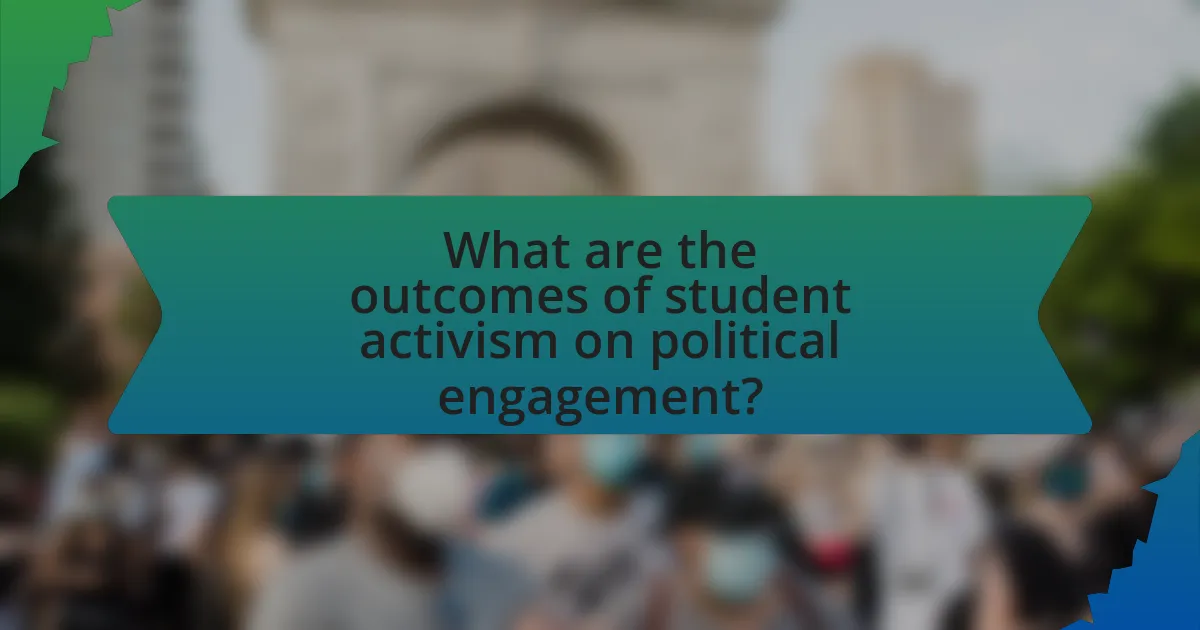
What are the outcomes of student activism on political engagement?
Student activism significantly enhances political engagement among young individuals. Research indicates that students involved in activism are more likely to participate in voting, advocacy, and civic discussions. For instance, a study by the Harvard Kennedy School found that students who engage in activism are 50% more likely to vote in elections compared to their non-activist peers. This increased engagement stems from heightened political awareness and a sense of agency fostered through activism, leading to a more informed and active citizenry.
How does student activism lead to increased voter participation?
Student activism leads to increased voter participation by mobilizing young individuals around social and political issues, fostering a sense of civic responsibility. When students engage in activism, they often organize campaigns, rallies, and educational events that raise awareness about the importance of voting. For instance, studies show that campuses with active student organizations report higher voter turnout rates, as these groups provide resources and information about registration and election processes. Additionally, student activism creates a culture of engagement, where peers influence each other to participate in elections, evidenced by the 2018 midterm elections, which saw a significant increase in voter turnout among young voters compared to previous years, largely attributed to student-led initiatives.
What strategies have proven effective in mobilizing student voters?
Effective strategies for mobilizing student voters include peer-to-peer outreach, social media campaigns, and collaboration with student organizations. Peer-to-peer outreach leverages personal connections, making students more likely to engage when approached by fellow students. Social media campaigns utilize platforms popular among students, such as Instagram and TikTok, to disseminate information quickly and create a sense of urgency around voting. Collaboration with student organizations enhances credibility and reach, as these groups often have established networks and trust within the student body. Research indicates that these methods significantly increase voter turnout among students, with studies showing that campuses employing these strategies saw turnout rates rise by as much as 20% compared to those that did not.
How do student-led movements influence broader electoral trends?
Student-led movements significantly influence broader electoral trends by mobilizing young voters and shaping political discourse. These movements often address pressing social issues, such as climate change and racial justice, which resonate with younger demographics. For instance, the March for Our Lives movement, initiated by students after the Parkland shooting in 2018, successfully galvanized youth participation in the 2018 midterm elections, resulting in a record turnout of young voters. According to the U.S. Census Bureau, voter turnout among those aged 18-29 increased from 21% in 2014 to 36% in 2018, demonstrating the impact of student activism on electoral engagement. Additionally, student-led initiatives often push political candidates to adopt progressive platforms, thereby influencing the overall political landscape and electoral outcomes.
What challenges do student activists face in political engagement?
Student activists face significant challenges in political engagement, including institutional barriers, lack of resources, and societal pushback. Institutional barriers often manifest as restrictions imposed by universities or governments, limiting the ability to organize protests or express dissent. For instance, many campuses have policies that require permits for demonstrations, which can hinder spontaneous activism. Additionally, student activists frequently encounter a lack of financial resources, making it difficult to fund campaigns, events, or outreach efforts. A study by the National Student Association found that 70% of student organizations reported budget constraints as a major obstacle to their activities. Societal pushback, including negative media portrayal and opposition from peers or community members, can also discourage student participation in political movements. These challenges collectively impede the effectiveness and reach of student activism in the political sphere.
How do institutional barriers affect student activism?
Institutional barriers significantly hinder student activism by limiting access to resources, restricting freedom of expression, and imposing bureaucratic obstacles. These barriers can manifest as administrative policies that require permits for demonstrations, which can delay or prevent student-led initiatives. For instance, a study by the American Association of University Professors found that restrictive speech codes and policies can stifle student voices, leading to decreased participation in activism. Additionally, financial constraints imposed by institutions can limit students’ ability to organize events or campaigns, further diminishing their impact. Overall, these institutional barriers create an environment that discourages active engagement and participation in political discourse among students.
What are the consequences of political repression on student movements?
Political repression significantly stifles student movements, leading to diminished activism and increased disillusionment among students. When governments impose restrictions on free speech, assembly, and association, students often face intimidation, arrests, and violence, which can deter participation in protests and advocacy. For instance, during the 2014 protests in Hong Kong, the government’s heavy-handed response led to a decline in student engagement and a sense of hopelessness regarding political change. Additionally, political repression can push student movements underground, resulting in fragmented organizations that struggle to mobilize effectively. Historical examples, such as the Tiananmen Square protests in 1989, illustrate how state violence can suppress student activism and create a climate of fear, ultimately stalling progress toward democratic reforms.
What best practices can enhance the effectiveness of student activism?
Effective student activism can be enhanced by organizing clear goals, building coalitions, and utilizing social media strategically. Clear goals provide direction and measurable outcomes, which can increase motivation and focus among participants. For instance, the March for Our Lives movement effectively mobilized students by centering on specific legislative changes regarding gun control. Building coalitions with other organizations amplifies voices and resources, as seen in the collaboration between various student groups during climate strikes, which significantly increased participation and visibility. Additionally, strategic use of social media allows for rapid dissemination of information and mobilization of supporters, exemplified by the viral spread of the #BlackLivesMatter movement, which engaged a global audience and fostered widespread activism. These practices collectively contribute to the effectiveness of student activism by enhancing organization, reach, and impact.
How can students build coalitions to strengthen their political impact?
Students can build coalitions to strengthen their political impact by collaborating with diverse groups that share common goals and values. This collaboration can involve forming alliances with student organizations, community groups, and advocacy networks to amplify their voices and resources. Research indicates that coalitions can enhance political efficacy by pooling knowledge and mobilizing larger numbers of participants, as seen in movements like the March for Our Lives, which united students across various campuses to advocate for gun control. By leveraging collective power, students can influence policy decisions and engage more effectively in the political process.
What resources are available to support student activists in their efforts?
Student activists can access various resources to support their efforts, including organizations, funding opportunities, and educational materials. Organizations such as the Student Activism Network and the American Civil Liberties Union provide guidance, training, and networking opportunities for activists. Additionally, funding sources like the Fund for Student Activism offer grants to support specific projects and initiatives. Educational materials, including workshops and online courses from platforms like Coursera and edX, equip student activists with essential skills in advocacy, organizing, and public speaking. These resources collectively enhance the effectiveness and impact of student activism.
